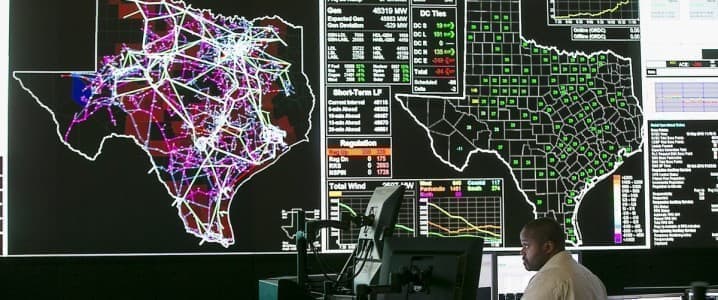In what now seems an almost annual event, Texas, the Midwest, and the Deep South are anticipating another episode of extreme cold, this time starting in the third week of January. The fear initially was that this might be like 2021’s winter storm Uri which triggered a grid collapse resulting in a days long power outage and hundreds of weather-related deaths across the state. As we write, It appears that the predicted polar vortex will be more benign from a grid perspective with less ice and a deep cold spell of more limited duration. ERCOT, the grid manager in Texas, has issued a weather notification to its customers but is not requiring any emergency measures. In brief, they seem to be saying this wintry, arctic event is no big deal. But the grid’s managers did offer some insights about their system. And that is what interests us.
First, they anticipate a maximum peak electrical demand of about 81 gigawatts versus about 90 gigawatts total capacity in their system. We won’t waste time here lecturing about adequate reserve margins (most of the country uses 15%+ minimums as a rule) and just accept that Texas cuts it close with electric reserve margins to save money. The important thing to note is that their winter peak load last year was about 65 gigawatts, so Texas projects a substantial 25% increase year-over-year increase. The 81-gigawatt demand estimate, however, is important for another reason. It’s almost as high as the peak summer demand of 85 gigawatts last August. Texas is obviously a summer-peaking electrical grid but winter demand peaks like this make it increasingly difficult to schedule long-term power plant maintenance outages. And while system managers struggle to keep the lights on, maintenance backlogs tend to increase with an adverse effect on reliability. The good news here is that the need for more in-state power generation is clear and the legislature has been considering subsidizing various remedies most of which center around more gas-fired generation. And while the local politicians have debated fossil-fueled power generation options, both solar and batteries have dramatically increased their penetration. Related: Surging Tanker Rates Make U.S Oil Too Expensive for Asia
Looking at that 81 gigawatt estimated demand projection also tells us several things about the load profile, especially with respect to residential demand. There is enormous potential here to limit or shape system demand with home insulation and other weatherization efforts given the extensive use of electrical, resistance-type heating. Also, ERCOT has avoided any policy even vaguely resembling demand-side management—encouraging or incentivizing customers to use less electricity during peak periods of grid stress. The good news here is that these policies have been proven successful in other places and represent low-hanging fruit. Any time the Texas grid managers want to begin to shape demand they have well-established tools at their disposal. The fact that they choose not to use them is a policy choice like not paying for Medicare expansion or children's nutrition. Until now Texas’ weatherization efforts have focused on the supply side: power plants, gas pipelines, unfreezing coal storage piles and the like.
From a power usage and demand perspective, electric deregulation in Texas has meant that terms like “conservation” are about as warmly regarded as terms like “gun control”. Yet deregulation can produce an economic free-for-all all, with potential winners and losers. In this environment, solar and batteries have thus far dramatically and rapidly increased their penetration. Looking ahead, of all the power-producing technologies (fossil, nuclear, wind), only solar and batteries are still experiencing dramatic downshifts in costs. Solar panels are increasing in efficiency while batteries are getting larger and their material components cheaper and more recyclable. In addition, batteries both compete with gas peakers and have begun to provide other grid-supporting services. They are becoming economically more competitive. Our prediction is that within five years the new natural gas-fired power-generating plants the legislature builds will be regarded as stranded assets. These traditional or legacy generating facilities will be increasingly incapable of competing with renewables which have high but declining capital costs, almost zero operating (i.e. fuel) expenses, and improving operating characteristics that further enhance profitability. Up until now the price of electricity has been the main concern for grid managers, especially as a tool for economic development. But given how essential electricity is for society's functioning, reliability of electric supply could become as important as an affordable price. And as distributed technologies like solar and batteries increase, consumers have more options, including the installation of their own power sources, while legacy power providers will face a growing existential threat.
If we’re right, then the next shoe to drop for legacy utilities will be a heightened risk notification from bond rating agencies, highlighting increased financial risks for investors. Relatively new technologies like solar and batteries can reshape our grid and change fundamental economic relationships. At a minimum, batteries have the potential to destroy the economics of gas peakers. It’s not that often we can observe classic Schumpeterian creative destruction up close like this. But the key question for us is when investors wake up and reevaluate this new technology risk.
By Leonard Hyman and William Tilles for Oilprice.com
More Top Reads From Oilprice.com:
- Biden Launches New Initiative to Empower Youths in Green Transition
- Argentina's Oil Revolution: Vaca Muerta Shale Fuels Economic Hope
- Copper's Critical Role in Green Energy Transition


















